Grafoil Gaskets
Welcome to the world of Grafoil—where innovation meets reliability. Discover how this unique material is transforming industrial sealing solutions, setting new standards in performance and safety.
What is a Grafoil gasket?
Gaskets are the defensive line in industrial use. The importance of a gasket performing to its intended use can be critical and even lifesaving. Liquids and gasses are always seeking a path of least resistance, and keeping them in check is what gaskets do best. They allow piping and fittings to be joined, providing the necessary bond for a functioning flow system to operate with integrity. Grafoil, developed in 1967 by NeoGraf Solutions, is a material made of natural graphite flakes and was the first fluid sealing material used in industrial applications. Rapidly adopted across oil and gas, automotive, pharmaceuticals, nuclear energy, and other industries, Grafoil gaskets offer unique characteristics:
- Pliable and Compactable: Grafoil gaskets can be cut and molded for various applications.
- Heat and Chemical Resistance: Resists harsh chemicals, corrosion, heat, and fire.
- Thermal Stability: Chemically inert and stable in high temperatures, up to 840°F (450°C). With an added oxidation inhibitor, it can withstand temperatures up to 975°F (525°C). In an inert environment, it can handle temperatures as high as 5400°F (3000°C).
- Shape Conforming Ability: Creates solid seals.
- Unlimited Shelf Life: Grafoil sheets and gaskets have an indefinite shelf life.
- Safety: No sharp edges minimize hazards.
Grafoil gaskets, manufactured into rolls or sheets, play a critical role in various industries, ensuring efficient and safe operations.

What is Grafoil used for?
Grafoil, known for its pliability, flexibility, and chemical and heat resistance, supports a wide range of industrial applications. From oil and gas to electronics and automotive, Grafoil is a trusted material for manufacturing high-integrity gaskets and seals. Developed by NeoGraf in 1967, Grafoil is made by mixing ground graphite particles with nucleic or sulfuric acid, resulting in a unique material ideal for:
- Oil and Gas Industry (Chemical Seals)
- Chemical Processing (Gaskets and Seals)
- Nuclear Science and Energy
- Heat Exchangers
- Electronics (EMI and RFI Shielding)
- Automotive Industry (Seals and Gaskets)
Grafoil sheets are available in various grades tailored for specific industry needs, ensuring reliable performance and durability.
How thick is a Grafoil sheet for laser cutting?
Manufacturers know their systems and equipment well. They must because so much responsibility to produce high quality goods and services is the foundation for the bottom line of revenue. Without consistent quality, that includes throughput and the overall customer experience, a manufacturing business would have a short run of operation. The knowledge of technology used goes hand in hand with the materials they are being asked to process with. For laser cutting technology this is equally important and is a constant source of communication between customers and the precision laser service providers. Many projects manufactured by laser technology are designed for use as a gasket or seal. With numerous industries needing a flow type system to operate with integrity, Grafoil material is a solid choice. Grafoil is a product of NeoGraf Corporation. This material is unique in that it has many properties and characteristics that are just suited for industrial applications. In brief, it is made by combining ground graphite particles with nucleic or sulfuric acid. This mixture is processed into rolls and sheets of varying thickness and grade types with characteristics such as:
- Heat and chemical resistance from harsh chemicals.
- Corrosion, heat, and fire resistant.
- Stable in high temperatures up to 840°F (450°C). With an added oxidation inhibitor, it can go to 975°F (525°C). A Grafoil gasket can withstand temperatures as high as 5400°F (3000°C) If used in an inert environment.
- Shape conforming ability creates solid seals by being pliable and compactable.
- Grafoil sheets and gaskets will have unlimited shelf life.

What is the best laser to cut Grafoil?
One of the best ways to cut gasket material is done by UV or ultraviolet technology. Ultraviolet laser systems have the right wavelength to obliterate Grafoil material to produce custom Grafoil gaskets. It is a non-contact system where the beam of intensified light is the cutting tool. With a small beam diameter of 20microns, Grafoil gaskets can be cut up to .060” mils thick on UV laser technology. With this versatility of cutting ultrathin gauges of materials from 0.001” (0.0254mm) on up, UV laser technology processes Grafoil sheets in the following way:
- The CAD or design file is uploaded to the laser system.
- The Grafoil sheet is placed on the bed and secured by vacuum.
- The laser operators dial in the settings needed to cut the type of Grafoil and thickness. These combined settings are called the “laser tool” and include adjustments of the laser power, laser traveling speed, laser focus, wavelength, and dwell time, to name a few.
- Like all manufacturing, a quality check is performed and sometimes called a “first article”. Upon review from an OGP system (Optical Gaging Product) or a similar quality system, the first article is approved, and production can ensue.
- The final steps will include final inspection and packaging.
There are other methods used in industry to produce gaskets such as die-cutting, molding, or extrusion. However, laser technology is the best way to cut gasket material out of Grafoil. A Grafoil gasket will function while being able to withstand harsh conditions due to its characteristics mentioned earlier of corrosion resistance and high thermal threshold. The best laser cut Grafoil will be done with UV laser technology. Grafoil gaskets are accurately manufactured by laser cutting, which supports both R&D and production volumes. For a laser cut Grafoil precision part, once in use will offer the end user confidence and integrity as a high-quality solution.
What are the benefits of laser cut Grafoil?
Laser cutting Grafoil offers several key benefits that directly contribute to achieving critical goals in industrial applications:
- Precision and Accuracy: The precision of laser cutting ensures that Grafoil gaskets fit perfectly, reducing the risk of leaks or failures in sealing systems. This level of accuracy is crucial for maintaining operational integrity and preventing costly downtime due to equipment malfunctions.
- Non-contact Process: By utilizing a non-contact cutting method, laser cutting preserves the purity of Grafoil without introducing contaminants or compromising its chemical and heat resistance. This is essential for industries like oil and gas, where even minor impurities can lead to system failures.

- Customization and Flexibility: Laser cutting allows for rapid customization of Grafoil gaskets based on specific project requirements. This flexibility enables manufacturers to quickly adapt to changing needs and optimize designs for enhanced performance and efficiency.
- Minimal Heat Affected Zone (HAZ): With laser cutting, Grafoil retains its critical properties such as heat and chemical resistance due to the minimal heat affected zone during cutting. This ensures that the material performs reliably in high-temperature and corrosive environments, supporting long-term durability and safety.
- Efficient Production: The efficiency of laser cutting reduces lead times and production costs, contributing to overall operational efficiency and profitability. This benefit is particularly important for industries where production speed and cost-effectiveness are paramount.
- Clean and Burr-Free Edges: Clean edges produced by laser cutting ensure tight seals without burrs or rough surfaces, enhancing the effectiveness and longevity of Grafoil gaskets. This quality control minimizes maintenance requirements and extends the lifespan of critical equipment.
- Versatile Thickness Capability: UV laser systems used for cutting Grafoil can handle various thicknesses, offering versatility in manufacturing gaskets and seals for different applications. This capability streamlines production processes and supports diverse industry needs.
These benefits collectively empower industrial manufacturers to achieve their goals of maximizing operational efficiency, ensuring safety and reliability, and meeting stringent performance requirements. Laser cutting technology, coupled with the unique properties of Grafoil, represents a strategic investment in optimizing industrial processes and delivering superior quality products essential for critical applications.
